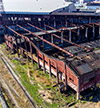34th Annual Survey of Corporate Executives Commentary: Search for Skilled Labor to Operate — and Build — the Facility Continues
A shortage of skilled workers to not only operate a facility but also to build one is driving up construction and occupancy costs.
Q1 2020
As the economy continues to see sustained growth, the available labor force continues to drive most site selection decisions. The shrinking unemployment rate coupled with lack of vocational and technical school graduates entering the workforce has really put an even greater emphasis on the availability of skilled labor in the site selection process. Labor studies today are not only analyzing the availability of skilled labor to perform production activities inside the facility, but the labor is also analyzed to determine the quantity and quality of the carpenters, electricians, plumbers, and masons who will build the production facility.
Due to the labor market capacity constraints, I was initially surprised to see that corporate users were not putting available buildings higher in the rankings to reduce overall costs. The drop from 9th place to 12th place in the past year was shocking considering the rise of construction costs from 10th place to 5th place. As corporate occupiers struggle to find optimal locations that meet their cost objectives, the biggest hurdle they face is not only building or finding a building, but also managing the capital costs associated with development of the physical structure. Today’s manufacturing operations and floors are not the same as Henry Ford’s Model T line; thus, in some situations, it might be more cost-efficient to develop a new facility than to rehabilitate an out-of-date facility.
As we march into this new decade, it will be interesting to see what production facilities of the future will look like and cost. As corporate users will continue to have to work harder to attract and retain this limited skilled labor force, will the inside of the facility continue to cost more, warranting more new development or rehabilitation of existing industrial space?
Project Announcements
LS Cable & System Expands Chesapeake, Virginia, Manufacturing Operations
12/22/2025
Anthro Energy Plans Louisville, Kentucky, Manufacturing Operations
12/22/2025
Novartis Expands Durham-Wake County North Carolina, Manufacturing Operations
12/21/2025
Momentous Expands Summit County, Utah, Operations
12/21/2025
Stryker Expands Salt Lake County, Utah, Operations
12/21/2025
Portal Space Systems Expands Bothell, Washington, Operations
12/21/2025
Most Read
-
The Workforce Bottleneck in America’s Manufacturing Revival
Q4 2025
-
Rethinking Local Governments Through Consolidation and Choice
Q3 2025
-
Lead with Facts, Land the Deal
Q3 2025
-
Investors Seek Shelter in Food-Focused Real Estate
Q3 2025
-
Tariff Shockwaves Hit the Industrial Sector
Q4 2025
-
America’s Aerospace Reboot
Q3 2025
-
The Permit Puzzle and the Path to Groundbreaking
Q3 2025



